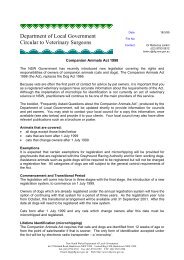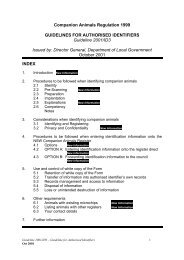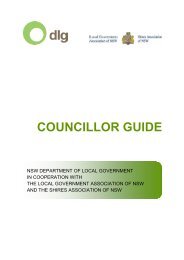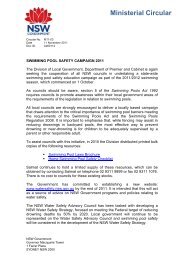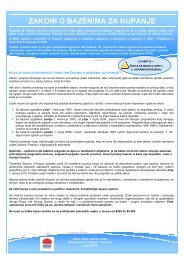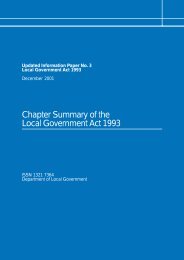Integrated Planning and Reporting Manual - Division of Local ...
Integrated Planning and Reporting Manual - Division of Local ...
Integrated Planning and Reporting Manual - Division of Local ...
You also want an ePaper? Increase the reach of your titles
YUMPU automatically turns print PDFs into web optimized ePapers that Google loves.
3. THE RESOURCING STRATEGY<br />
3.2 Long Term Financial <strong>Planning</strong><br />
<strong>Local</strong> Government Act<br />
Council’s Resourcing Strategy must include provision for long-term financial planning.<br />
Essential Element 2.1<br />
Each council must prepare a Long Term Financial Plan.<br />
Essential Element 2.2<br />
The Long Term Financial Plan must be used to inform decision making during the finalisation <strong>of</strong> the<br />
Community Strategic Plan <strong>and</strong> the development <strong>of</strong> the Delivery Program.<br />
Essential Element 2.3<br />
The Long Term Financial Plan must be for a minimum <strong>of</strong> 10 years.<br />
The Long Term Financial Plan is an important part <strong>of</strong> Council’s strategic planning process. This is<br />
the point where long-term community aspirations <strong>and</strong> goals are tested against financial realities. It<br />
is also where Council <strong>and</strong> the community may decide what resources councils need to influence<br />
<strong>and</strong> work with other parties so that they might deliver on responsibilities.<br />
The Community Strategic <strong>Planning</strong> process will provide Council with valuable information about the<br />
future. From the exercise, both Council <strong>and</strong> the community will have a better underst<strong>and</strong>ing <strong>of</strong>:<br />
<br />
<br />
<br />
<br />
Expected pressures that will affect the community socially, environmentally <strong>and</strong><br />
economically <strong>and</strong> the drivers behind this change<br />
Expected economic growth rates<br />
The community’s aspirations <strong>and</strong> priorities for improving its economic, environmental <strong>and</strong><br />
social outcomes<br />
The community’s priorities in terms <strong>of</strong> expected levels <strong>of</strong> service <strong>and</strong> community projects.<br />
The Long Term Financial Plan will seek to answer the questions:<br />
Can we survive the pressures <strong>of</strong> the future<br />
What are the opportunities for future income <strong>and</strong> economic growth<br />
Can we afford what the community wants<br />
How can we go about achieving these outcomes<br />
The Long Term Financial Plan (LTFP) is a decision-making <strong>and</strong> problem-solving tool. It is not<br />
intended that the LTFP is set in concrete – it is a guide for future action. The modelling that occurs<br />
as part <strong>of</strong> the plan will help councils to weather unexpected events. It will also provide an<br />
opportunity for Council to identify financial issues at an earlier stage <strong>and</strong> gauge the effect <strong>of</strong> these<br />
issues in the longer term.<br />
The longer the planning horizon, the more general the plan will be in the later years. For example,<br />
it is not expected that the 10 th year <strong>of</strong> a 10 year plan will include specific detail.<br />
As decisions are made, more detail can be added to the LTFP. For example, as Council finalises<br />
its Delivery Program, the first four years <strong>of</strong> the LTFP will become firmer. As the Operational Plan is<br />
completed, the detailed budget will form the first year <strong>of</strong> the Long Term Financial Plan. The<br />
diagram following shows the relationships.<br />
<strong>Planning</strong> & <strong>Reporting</strong> <strong>Manual</strong> Page 60 <strong>of</strong> 115






